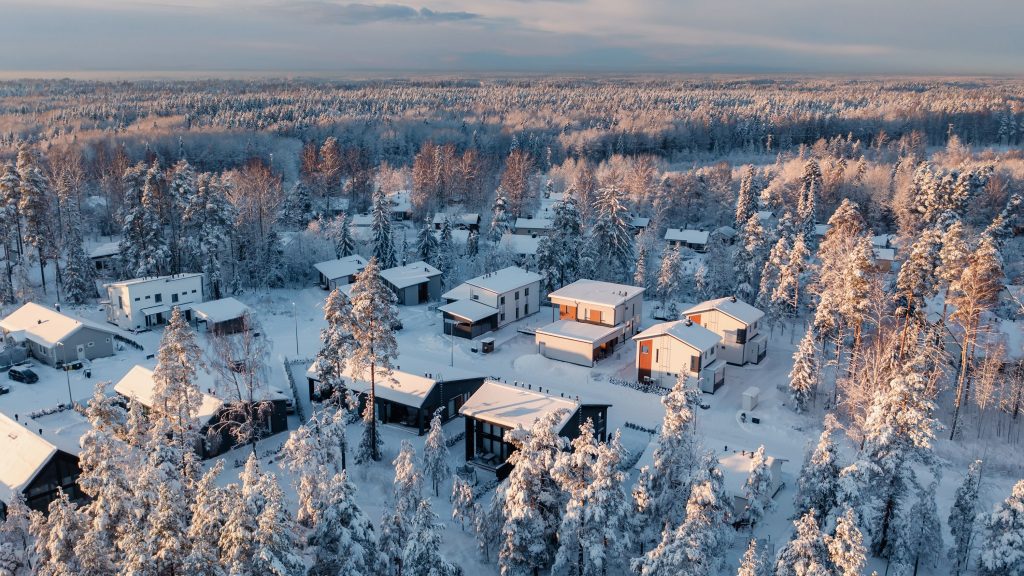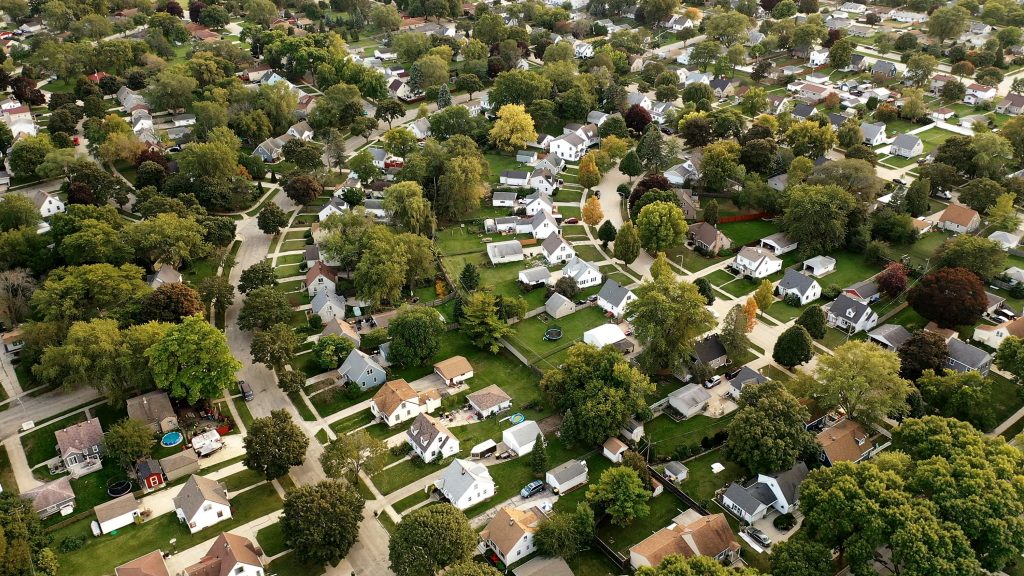You may not know them by name, but you know them by sight — Craftsman Style houses are everywhere in the US and are one of our most loved architectural styles.
From the beaches of the Pacific to the woods of New England, the Craftsman Style has become synonymous with Americana and the American ideal of “home”, so the style is highly sought after across the nation.

What defines a Craftsman Home?
Several features give Craftsman its distinctive look. Typically, Craftsman Style homes have a large, low-pitched roof with a large front porch and on the inside, there’s usually a lot of wood detailing.
They feel warm, homely, and historic-feeling, without being staid, and have ornamental, but practical touches everywhere, making these classic houses a delight to behold and to live in.
Where does the term Craftsman originate?
New York state is the birthplace of several iconic art and design movements and the term “Craftsman” originally referred to a style of furniture popularized by NY resident, Gustav Stickley.
Stickley’s furniture was very popular at the turn of the century and he soon began to apply his design aesthetic to interior and exterior design.
The influential architects Charles and Henry Greene of Pasadena, California, were getting interested in the allied English Reactionary and Oriental Wood schools of architecture around the same time.
And periodicals like House Beautiful and Ladies’ Home Journal were also popularizing the new Craftsman Style and it soon began to spread across the country.
The history of Craftsman Homes
The late 1800s saw a blossoming of several variations of the Craftsman Style, which itself drew heavily on the Arts and Crafts Movement that began in England in the mid-1800s.
Arts and Crafts was a response to an increasingly industrialized world and was inspired by the ideas of historian Thomas Carlyle, art critic John Ruskin, and designer William Morris.
Morris famously said, “have nothing in your house that you do not know to be useful or believe to be beautiful,” and the movement promoted handicrafts and artisanship over mass production.
What are the benefits of a Craftsman Home?
Craftsman homes are generally full of detail and attractive features and are considered to be very well-built and thoughtfully designed.
Made of quality materials such as wood, brass, copper, and wrought iron, they exude style and quiet refinement, and their structural elements give them a much-appreciated solidity and durability.
What characteristics define Craftsman Homes?
Craftsman Style houses are frequently “one-offs” and are full of character. The workmanship and attention to detail they exhibit are of a high order and nearly every aesthetic element found in them is unique to the style, and often, the individual property,
Entryways: combining natural beauty with practicality
The entrance to a Craftsman Style home very often features a “mudroom” — a space with a handcrafted wood bench and coat rack where footwear can be removed in comfort without traipsing mud into the main house.
Wood-framed mirrors are another common feature that often graces Craftsman Style entrance halls.
Doors: sturdy and inviting statement pieces
The front door to a Craftsman Style home is invariably made of wood — often premium mahogany, oak, or cherry — and often features clear or stained-glass window panels at the top.
Windows: signature pieces with geometric flair
Craftsman Style houses make use of several distinct types of windows, with the most common being a “double-hung” window, or “sash” window, as it is known elsewhere.
This type of window design is notable for having panes that slide up and down vertically, not outwards, as is common with many other architectural styles.
A Valence grid window is another typical feature of Craftsman and consists of three smaller glass sections at the top of the window, with a larger single pane below.
Colors: comforting palettes and tones
Muted and natural-looking browns, greens, and reds are the hallmark colors of a Craftsman Style home, with the roof generally a brown color.
Sage green or olive are often chosen for the walls, with rusty reds used as accent colors. Other exterior colors can be muted blues, grays, creams, or browns
Roofs: unmistakable silhouettes
The Craftsman Style normally only has one or two stories, although some modernized homes may have had extensions added.
Their low-pitched, triangular, and often gabled roofs were originally covered with wooden shingles, although sadly, most have now been replaced with more easily maintained modern tile and slate.
Siding: traditional materials that define Craftsman houses
One frequently encountered characteristic of the Craftsman Style house is horizontal wooden clapboard siding.
Rather like the “clinker-built” hull of a traditional wooden boat, the wooden panels are laid overlapping one another and define the chocolate-box quaintness of the style.
Porch: the essential Craftsman touch
Essential to any Craftsman house is a large, covered porch with columns that taper from a wide base to a narrower top.
Another common feature is a wooden bench or swing under the roof of the porch — a great place to watch the world go by.
Fireplaces: warmth with aesthetic balance
Craftsman homes feature elegantly simple brick or stone fireplaces topped by wooden mantle pieces, often flanked by stonework or ceramic tiles arranged in aesthetically pleasing geometric patterns.
These fireplaces form the heart of the home and are one of the style’s best-loved features.
Flooring: organic, natural, and grounding
As we’ve discovered, wood is the most prevalent material in a Craftsman home and the floors are no exception, although muted natural stone tiling is often found in bathrooms and kitchens.
Lighting: fine details create illuminated refinement
The style makes good use of lighting to illuminate and highlight the other features of the house and it’s common to find intricate geometric patterns and stained-glass lighting features in Craftsman homes.
Hardware: heavy with an emphasis on quality
Renowned for their beautiful design and made of quality materials such as brass, copper, and steel, the hinges, doorknobs, handles and other fixtures of a Craftsman home make the mundane actions of everyday living a joy.
The furniture you traditionally find inside Craftsman Homes
Benches that blend in beautifully
The thought that went into the design of Craftsman Style houses is evident everywhere. One aspect of this is strategically-placed wooden benches anywhere you might want to admire the view, stop to catch your breath, or take off your muddy boots.
H3 – Beds, Chairs, and Couches crafted for long-lasting use
Following the Arts and Crafts ethos, the furniture originally found in Craftsman Style houses was handcrafted and designed for beauty, utility, and long service.
The beds were wood-framed and used the same geometric designs found elsewhere in the house. The wooden chairs and couches were equally elegant, with fabric-covered cushions for beauty and comfort.
Shelving: supportive and sturdy fixtures
Good storage was always a consideration in Craftsman design, and because of the period the houses were built in, books took pride of place, with wooden shelving often built into the walls of studies, workspaces, and libraries.
Tables: statement pieces for serving
Eating, cooking, crafting, and just getting together with a drink is always easier when you’ve got a large solid table. The Craftsman designers knew this and used well-built wooden dining, end, and coffee tables to good effect throughout their buildings.
The Different Types of Craftsman Homes
Bungalow: the classic trademark style
The word “bungalow” is Hindi in origin and denotes a modest single-floor house with large front porches. In the US, the bungalow style is known as the “original” Craftsman style and it works very well in the variable North American climate.
The style originated in Bengal, India and the large porches were originally intended to keep occupants cool by encouraging cooling breezes and providing shade.
(The style was also enthusiastically adopted by the British, which is strange, considering the British weather…)
Prairie-Style: the famous style with a flat roof
It was the renowned architect, Frank Lloyd Wright, who made the prairie-style home famous in the US. With its horizontal, unpitched roofline designed to blend in with the landscape, the style epitomizes elegant but rugged, down-home living.
Mission Revival: Craftsman meets the Mediterranean
As Craftsman spread through the southwest, it was only a matter of time before the Spanish Mission Style influenced it, leading to Mission Revival — a synthesis of the original with a dash of Spanish panache.
Four-Square Craftsman: the classic layout
The “Four Square” style of Craftsman architecture is a larger format of the original style and was originally intended for families on a budget. Although less ornate in detail, they generally have more square footage. “Four Square” refers to a layout of four rooms in each storey.
Tips to preserve Craftsman details
As with all heritage buildings, taking the time and effort to understand the history and features of your Craftsman home is time well spent.
Local historians and building conservators possess a wealth of knowledge on the subject and of course, there’s a vast amount of information available on the internet.
Tip one: Consider the time period when choosing hardware
If you do need to replace fixtures, matching periods is important, so try to find hardware and fittings that match your home’s age.
Tip two: Find local artisans
Caring for a heritage home means there are fewer suitable off-the-shelf features and fittings available, so it might be a good idea to find a skilled local carpenter or craftsperson who can make bespoke parts for your home.
Tip three: Befriend and patronize antique dealers
Sourcing furniture that matches your home is all part of the fun of owning an older house, so scour your local flea markets, make friends with antique dealers, and look out for yard sales where you might find furniture to fit your home’s aesthetic and style.
Tip four: Preserve the historic integrity of your floor plan
Try not to change the floorplan of a Craftsman Style house. Open-plan living may be the big thing these days, but ripping out walls and features could ruin a period home and devalue your investment.
Tip five: Consult with an interior designer
When it comes to decorating and furnishing a Craftsman house, it pays to consult a good interior designer who is well-versed in the design elements found in the Craftsman Style.
How to renovate a Craftsman Home
Taking on a major renovation of a Craftsman Style house needs special consideration and careful planning to preserve the house’s historic integrity.
Again, there are specialists who can advise you, but in general, avoid painting over wood or creating high-gloss finishes. Muted, matt paint schemes are a hallmark of the style and should be preserved or restored where possible.
Updating kitchens and bathrooms are often high on new owners’ job lists, but even here it pays to be sympathetic to the original building and source fixtures and fittings that complement the house’s original style.
Your Craftsman interior design style guide
Often described as warm and inviting, the Craftsman Style achieves its homely feel through the prolific use of wood and other natural materials, and by the restrained use of soft furnishings.
A paired-back, minimalistic approach to interior design highlights a Craftsman house’s best features and details; it’s better to let the house “speak for itself”, rather than overfill it.
If you can’t source or afford original Craftsman furniture, good quality mid-century, and minimalistic contemporary furniture pairs well with the style.
Characteristics of Craftsman-Style living rooms
Cozy and rustic, yet aesthetically refined, a good Craftsman living room is the kind of place where you just want to “be”.
And with a wood-mantle fireplace and natural earth-colored tones, a Craftsman Style living room is always a pleasure to spend time in.
Authentic Craftsman-styled kitchens for home chefs
The Craftsman Style kitchen embodies all the features that make up the ideal country kitchen and you’ll often find yourself spending more time there than anywhere else.
With glass-paneled cabinets, sturdy and robust fittings, and simple geometry, the Craftsman kitchen emphasizes quality construction, solidity, and homeliness.
Examples of Craftsman Homes with prices
The Craftsman Style can be found across the US. Here are some great examples to whet your appetite:
Oakland
- Four bed
- 3.5 bath
- 2,493 sq ft
- $2,598,000
- See more Craftsman-style homes for sale in Oakland, California.
Harrisburg
- Four bed
- Four bath
- 2,354 sq ft
- $175,000
- See more Craftsman-style homes for sale in Harrisburg, Pennsylvania.
Durham
- Three bed
- Two bath
- 1,740 sqft
- $380,000
- See more Craftsman-style homes for sale in Durham, North Carolina.
San Diego
- Four bed
- Two bath
- 1,432 sq ft
- $1,650,000
- See more Craftsman-style homes for sale in San Diego, California.
Boston
- Three bed
- 2.5 bath
- 1,802 sqft
- $1,350,000
- See more Craftsman-style homes for sale in Boston, Massachusetts.
Sacramento
- Five bed
- Four bath
- 4,886 sq ft
- $2,850,000
- See more Craftsman-style homes for sale in Sacramento, California.
Craftsman Style Homes FAQs
Why are Craftsman Homes so popular and enduring?
From inception to execution, original Craftsman Style houses were designed to be high-quality abodes that turned everyday features into objects of beauty and utility.
Appealing to people who appreciate refined aesthetics and quality construction, they speak to people from all walks of life, so be assured — good examples will always be in demand and will always hold their value well.
Who coined the phrase Craftsman style?
The term Craftsman Style was first coined by the American furniture designer Gustav Stickley in 1900.
Born in Wisconsin to German émigré parents, Stickley established the Craftsman magazine to promote the Craftsman ethos (and his own furniture designs) — with the first two issues paying homage to the style’s early advocates, William Morris and John Ruskin.
His design ideal was based on simplicity, honest construction, and empathy with materials, and his furniture is now back in vogue, with good examples fetching premium prices at auction.
How much do Craftsman Houses cost?
Craftsman houses cover a wide price range, with value determined by their size, location, and condition.
But, as is the case with other classic styles, Craftsman houses generally command higher prices than more modern, but similarly-sized properties because of their build quality and desirability.
Difference between Bungalow and Craftsman style
There’s sometimes confusion between the terms Bungalow and Craftsman Style, so just remember that Craftsman came first and “Bungalow” was one of the first subtypes of the style.
“Craftsman” is also a more general term that refers to the school’s furniture, lighting, and furnishing designs.
Is a Craftsman Home right for you?
If you enjoy the look and feel of natural materials and appreciate old-time handiwork and quality, the answer may very well be yes.
Just remember that old houses have their own character and need to be “listened” to, so if you’re looking for a blank canvas on which to unleash your inner interior designer, you might be better served by a more modern build.
How to modernize a Craftsman Home
The Craftsman style originated in the mid-1800s but its design features and aesthetic continue to influence modern architecture to this day.
It’s perfectly possible to buy a modern imitation of the style and have your cake and eat it: a timeless and classic design that’s in tip-top condition with all the modern conveniences.
But if you are buying an original build, just remember to pay attention to preserving the property’s historical details; these houses deserve to be treated well — they’re part of a long tradition of American craftsmanship and know-how.
Conclusion
Craftsman Style houses are some of the most desirable classic properties on the market today and offer the chance to own a quintessential piece of American architectural history.
It’s no wonder — with their unique designs, unparalleled build quality, and attention to detail, they are guaranteed to remain at the top of people’s property wishlists for decades to come.
Craftsman style homes for sale in Portland, Oregon.
Craftsman style homes for sale in Denver, Colorado.
Craftsman style homes for sale in Oakland, California.
Craftsman style homes for sale in Harrisburg, Pennsylvania.
Craftsman style homes for sale in Durham, North Carolina.
Craftsman style homes for sale in San Diego, California.
Craftsman style homes for sale in Boston, Massachusetts.
Craftsman style homes for sale in Sacramento, California.










